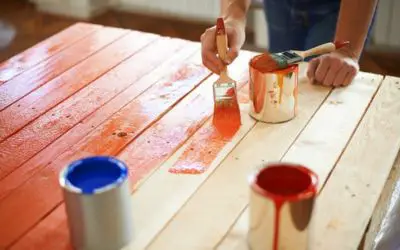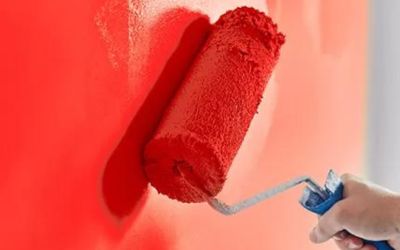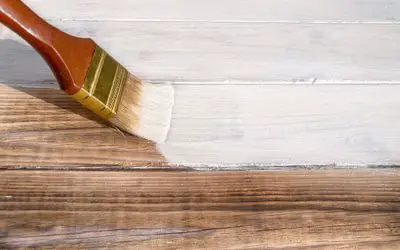Enamel paint forms a durable hard shell on surfaces, providing reliable protection for the coated surface.
However, if the surface you want to touch up already has a coat of acrylic paint, you must decide whether to remove the acrylic paint coat first or add the enamel paint over it.
But can you paint enamel over acrylic paint? Enamel paint has an oil base, while its acrylic cousin is water-based.
While the difference in bases could be an issue, understanding the two paint types can help you approach them correctly for the desired results.
In this guide, I will discuss the difference between acrylic and enamel paint and how to apply one over the other.
Can You Paint Enamel Over Acrylic Paint?
Yes, applying enamel over acrylic paint is possible if you prepare the surface properly before painting it. You must clean, sand, and prime the acrylic paint surface for the enamel product to adhere to it.
Without this surface prep, enamel paint will not stick to acrylic since one is oil-based and the other (acrylic paint) is water-based.
Also, this project will only succeed if the acrylic paint has no topcoat sealant.
Additionally, the painted surface must be intact, with no chipped or bubbled areas to hold the fresh coat of enamel paint.
If the acrylic paint layer is damaged, consider stripping it down or removing it before applying the enamel paint.
Even though this alternative may mean more work, it will save you the hassle of doing the entire work again.
What is the Difference Between Acrylic and Enamel Paint

A little background information is crucial to understand how to work with enamel and acrylic paints. Here is how the two paint types differ.
Base
As already mentioned, enamel paint has an oil base. This formula makes it velvety and appealing to the eye in most cases.
Acrylic paint is water-based, making it low in volatile organic compounds and safe to use indoors.
Primary uses
Enamel paint is primarily used on exterior walls and other outdoor projects. The paint is highly resilient and resistant to the elements, making it ideal for use outside.
On the other hand, acrylic paint is typically used indoors on interior walls and other interior projects.
Sheen levels
Thanks to its oil-based formula, enamel paint forms a glossy sheen when dry. On the other hand, acrylic paint has a matte finish. This surface characteristic is due to its water base.
Drying time
Like most oil-based products, enamel paint has a long drying time. Once you finish applying it to your project, the surface will take 8 to 24 hours to dry, depending on the weather conditions and the kind of enamel paint used.
In contrast, acrylic paint dries pretty fast. You can expect the surface to dry to the touch in 30 to 60 minutes after application.
Naturally, factors such as temperature, humidity, and the thickness of the layers will influence this drying time.
Color retention
The tough, hard-wearing coat of enamel paint naturally goes yellow over time. Using household cleaners, especially those with ammonia, tends to accelerate the yellowing of enamel paint.
In contrast, yellowing is not a problem with acrylic paint. This paint type retains its color over time, making it ideal for coating art and ornamental pieces.
Which is Better, Acrylic or Enamel Paint?

The better paint between enamel and acrylic depends mainly on the project’s requirements.
If durability is the main consideration, enamel paint should be the preference as it lasts much longer than acrylic paint.
Enamel paint resists cracking and fading, making it a superior choice. However, it will naturally yellow over time, especially when exposed to some cleaning products.
Enamel paint boasts better adherence to various surfaces, including plastic, glass, metal, and wood.
However, you may choose acrylic paint over enamel if you prefer an environmentally friendly option.
Acrylic paint has a water base in its formula, making it low-VOC and low odor.
You may also find enamel paint more challenging to work with than acrylics. The former has a steeper learning curve that may require more patience and attention to detail for a new DIYer.
What Happens When You Paint Enamel Over Acrylic Paint?

The outcome of painting enamel over acrylic depends on how well you prepare the surface before applying the enamel paint.
As long as you clean, sand, and wipe the surface before coating it with enamel paint, it should work well.
However, without proper surface preparation, the layer of enamel paint will bubble or peel and fall off over time.
Most acrylic paints require a clear topcoat to make the paint job last. The topcoat also usually protects the acrylic paint from oxidation, water, and chemical damage.
You must sand down and remove the protective topcoat to refinish the painted item.
This is an essential step when painting enamel over acrylic paint to guarantee better adhesion.
Applying enamel pain over acrylic without the required surface preparation prevents the coat of enamel paint from sticking and adhering properly.
The two paint types do not mix since one is oil-based and the other is water-based. This is what causes the topcoat to peel off.
Possible outcomes
People report mixed results when they apply enamel paint over acrylic. This article dissects the outcomes, putting them into perspective to help you understand what to expect and why.
A clear understanding of the possible outcomes and the reasons behind them should help you choose the right approach to guarantee success.
- The enamel paint can stick to the acrylic paint successfully
If you prep the surface and remove any topcoat before covering it with enamel paint, the chances are that you will be successful.
The enamel paint will likely grip the prepared acrylic surface, leading to a successful project.
You must clean the surface, sand it properly, and apply a compatible primer to create a much-needed medium for the enamel and acrylic paints to stick together.
- Bubbles may form
If you apply enamel paint over acrylic paint before the latter is completely dry, the enamel may form bubbles and fall off.
Enamel paint will not stick to a wet acrylic surface even if you sand it. The wetness creates a high chance of the new coat of paint forming tiny air pockets and bubbles and eventually falling off.
You can expect the same outcome if you rush the painting or go for the wrong combination of enamel and acrylic paints.
Rushing the process can also result in a textured or shrunk topcoat, eventually falling off.
- The paint job may peel and fall off.
Since most acrylic paint projects usually have a clear topcoat, you might apply enamel paint over the sealant. Doing so will almost guarantee undesirable results.
Since the topcoat creates a glossy barrier, enamel paint will not stick properly. You must remove the coat before painting. Otherwise, the paint job will not last. Instead, it will peel off once dry and fall off over time.
Common issues to avoid
While painting enamel over acrylic is challenging, you can increase your chances of success by approaching it correctly. Here are some issues to avoid in the process.
- Rushing the drying process. Each coat of paint needs adequate time to dry before adding another. If you rush it, you increase its chances of bubbling and falling off.
- Applying thick layers of paint. Enamel paint dries faster and better when you keep the layers thin. Applying thick layers increases the risk of everything going wrong.
- Rushing the application process. Enamel paint requires patience and careful application. Rushing the application process increases the risk of doing it incorrectly, leading to mistakes. Such mistakes can cost you the entire project.
- Applying enamel paint on a wet acrylic surface. Enamel paint does not mix with acrylic paint. However, it will stick to the acrylic surface if it is clean and well-sanded to provide a good grip. However, if the surface is not thoroughly dry, the fresh enamel layer will bubble and eventually fall off.
Preparing the Surface for Enamel Paint
You probably know by now that proper surface preparation is crucial and determines your success when working with enamel and acrylic paint.
This section walks you through the process of preparing your acrylic-painted surface to accept a fresh coat of enamel paint.
Tools and materials needed
- Mild cleaning detergent
- Sandpaper
- Sander
- Hand gloves
- Clean rags or clothes
A step-by-step guide to preparing the surface
If you are working with an old acrylic paint that has stayed on the item for a while, you can proceed to clean it.
However, inspect it for any cracks and chipping areas. You must only paint enamel over acrylic if the acrylic paint coat is sound.
If the paint is damaged, with chipping or peeling areas, the chances are that it will not hold the new coat of oil-based enamel paint—consider removing it before repainting the piece.
If the acrylic paint is fresh, allow it to dry thoroughly before attempting to paint over it.
Acrylic paint dries to the touch in 30 to 60 minutes, but allow it a minimum of 48 hours of drying time before attempting to paint with enamel over it.
That said, here are the steps for preparing your acrylic paint surface for a fresh coat of enamel paint.
Step 1. Clean the surface with a mild cleaning detergent. This helps remove any dirt and grime that might stand in the way of the new paint coat and hinder adhesion.
Step 2. Sand acrylic paint off the surface with a medium 180-grit sandpaper. Sanding helps scuff up the acrylic surface and gives the new paint something to grip. This step goes a long way in improving adhesion. Thorough sanding is also essential if the acrylic paint has a clear coat of sealant over it.
Step 3. Wipe the surface with a damp cloth to remove the sanding dust. After sanding, use a damp cloth to remove the sanding dust. Any dust trapped between the final paint coat and the acrylic surface will create a textured surface with unsightly bumps. Clean it to avoid that.
How to Apply Enamel Paint over Acrylic Paint
Once you have followed the above procedure to prep the surface, it is time to paint it. Follow the procedure below to apply enamel paint over acrylic.
Required tools and materials
- Protective hand gloves
- Compatible paint primer
- Enamel paint
- Applicator
How to paint enamel over acrylic paint step-by-step
Ensure you have all the tools and supplies for completing the task. Once you have everything you need, follow the steps below to complete the project.
Step 1. Prime the surface
Once the surface is ready for painting, apply a coat of compatible primer. The product acts as the bond that bridges the acrylic and enamel paints, guaranteeing adhesion.
Priming also helps ensure the enamel paint lasts longer. Follow the instructions on the product’s label to ensure you apply it correctly, then let it dry before painting over it.
Step 2. Apply a thin coat of your selected enamel paint
When the primer has dried for the recommended time, apply the paint according to the manufacturer’s instructions.
Check the label of your chosen product for these instructions and follow them to ensure you are using the product correctly.
Ideally, check the product to confirm whether the thinners in its formula may interact with the acrylic paint.
If unsure, you can consult with your supplier for this information. Alternatively, you can look up the paint you intend to use for information about its compatibility with the existing paint.
Enamel paint products with strong solvents may not properly adhere to a painted surface.
After confirming that you have the right product, use a natural-bristled brush to apply it to your project.
Notice that the paintbrush may cause friction that increases the risk of the acrylic paint peeling off. So I recommend going for an airbrush wherever possible.
But if you must use the paintbrush, be careful and use gentle pressure to avoid excessive friction.
Paint the surface with light strokes across from one end to the other until you have covered every inch of it.
Ensure each coat is thin and even.
Step 3. Let it dry and recoat
Allow the thin coat of your selected enamel paint dry thoroughly before recoating.
Once it is dry, use the same approach to apply a second coat, using light pressure and long, even strokes.
Since you are using light coats, I usually find applying multiple coats necessary for good coverage.
Applying 2-3 thin layers of enamel paint instead of one thick layer does it for me.
How to Tell if the Paint is Oil- or Water-based
To tell if the paint is oil or water-based, dampen a rag with some methylated spirit and use it to wipe at a small section of the painted surface.
If the paint stains the damp rag, it is water-based. Otherwise, the paint is oil-based.
Can You Paint Enamel Over Acrylic Primer?
Yes, you can use an acrylic primer with enamel paint. I prefer acrylic primer for paint because it provides better coverage and adhesion.
The secret is to let the primer dry completely before painting over it with the enamel product.
What Primer Do You Use With Enamel Paint?
Enamel paints typically require primers that promote adhesion to surfaces like metal, wood, or plastic.
Recommended primers for enamel paints include acrylic, shellac, and alkyd primers. Rust-Oleum Zinsser Cover Stain Oil-Base Primer is an example of a suitable primer for enamel paint on such surfaces.
Ultimately, the choice of primer should depend on the specific surface and type of enamel paint used for best results.
Do You Need to Prime or Seal Acrylic and Enamel Paints?
When applying acrylic paints, you need to prime the surface for better adhesion, especially for smooth surfaces like plastic and metal.
Acrylic paints also require a sealant on top to prevent them from peeling off easily.
Unlike acrylic paint, enamel paint does not require a primer because it adheres well to smooth surfaces, including metal, glass, wood, and plastic.
It is the most durable type of paint, so it does not require a sealant.
Here is an article on how to seal acrylic paint to help you
Here is an article on how to seal acrylic paint to help you achieve a long-lasting, professional-looking finish.
Can You Paint Acrylic Paint Over Enamel?
No, you cannot apply acrylic paint directly over enamel paint and achieve the desired adherence.
The water-based acrylic paint will not stick to the oil-based and often slick enamel paint surface. If you must apply acrylic paint, you must first sand off the enamel paint.
Tips for a Successful Enamel-over-acrylic Paint Job
- Always test the acrylic-painted surface to see if it has a sealant before applying enamel paint on top.
- Prepare the surface by cleaning, sanding, and priming it before painting.
- Be patient when applying enamel over acrylic paint, and let each coat dry thoroughly before recoating.
- Keep each coat of enamel paint thin for the best results.
- Keep a light touch when applying enamel over acrylic paint.
FAQs
What paint can go over acrylic paint?
Any water-based and oil-based paint can go over acrylic paint because it is water-based. However, ensure you check if the painted surface has a sealant and remove it before priming and painting over it for proper adhesion.
Can You Mix Enamel and Acrylic Paints?
No, you cannot mix enamel and acrylic paints because one is oil-based and the other water-based. Oil and water don’t mix, which explains the acrylic and enamel paint compatibility issue. While it is possible to apply enamel over acrylic, avoid the vice versa. Acrylic over enamel paint can lead to cracking, flaking, and chipping.
Can you paint over acrylic paint?
Painting over acrylic paint is possible as long as the acrylic paint has no sealant over it. However, applying acrylic, water-based paint over oil-based paint is not possible as the fresh coat of acrylic paint will not stick to the oil-based base coat.
What is the difference between latex and enamel paint?
Latex paint, based on water and containing acrylic or vinyl acrylic, provides quick drying and easy clean-up properties. For this reason, it is ideal for walls and general interior applications. Enamel paint being oil-based with alkyd resins or linseed oil, offers a durable and hard finish. All in all, the choice between enamel paint vs latex depends on specific project needs and surface usage.
Can You Paint Enamel over Acrylic Paint?
Painting with enamel over acrylic paint is challenging but entirely possible. Begin by ensuring that the acrylic paint is sound and has no sealant on top.
Then clean and sand it. After sanding, apply a compatible primer to the acrylic paint surface and let it dry.
After this preparation, you can successfully apply your enamel paint over the acrylic base coat.
This guide has provided the entire procedure for painting with enamel over acrylic paint. If you follow the steps correctly, your paint job should be a success.
Happy painting!











Leave a Reply